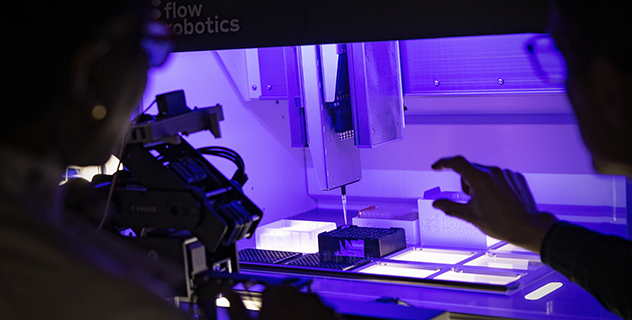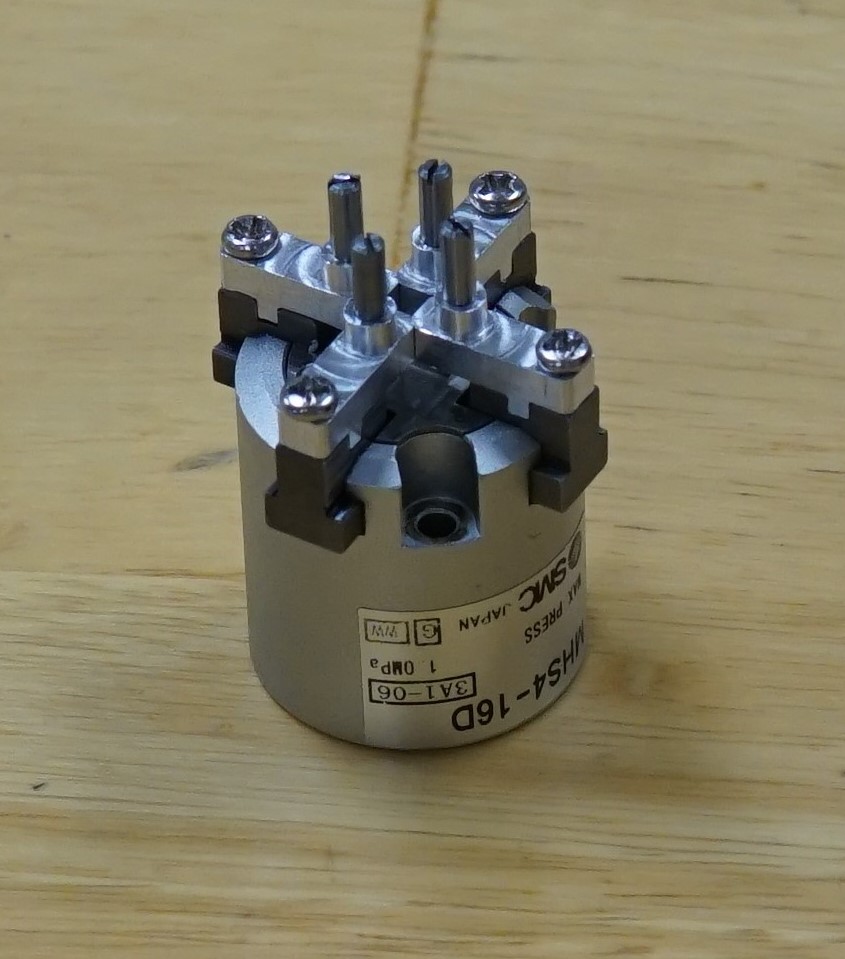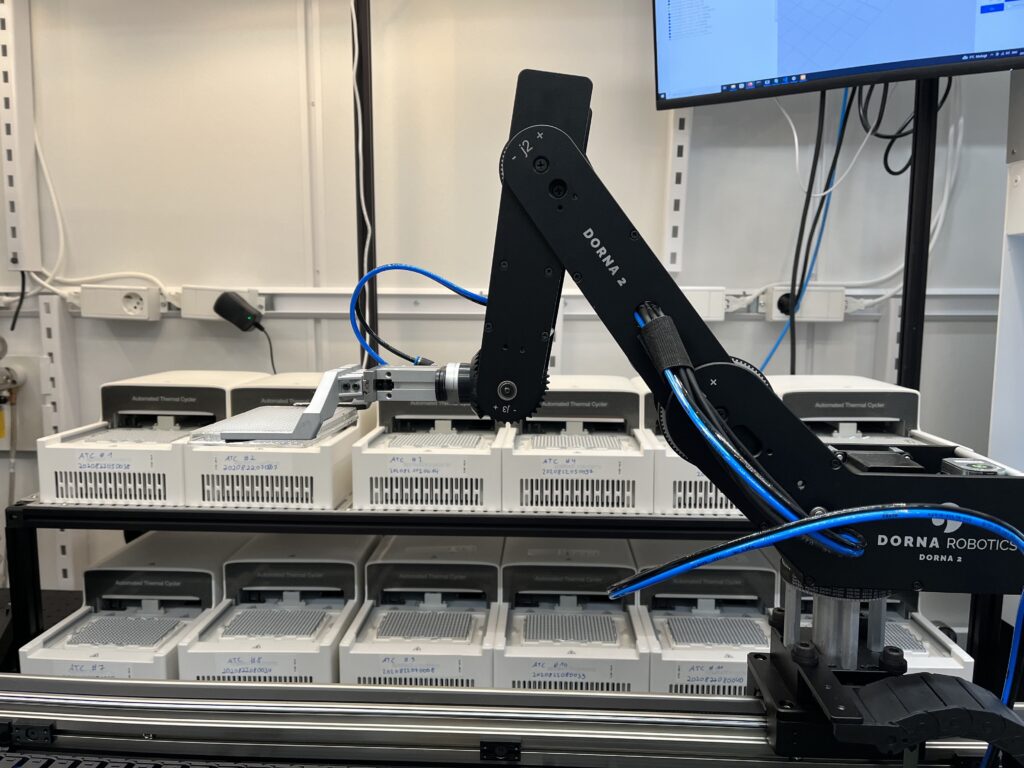Lab Automation
University Bioscience Lab
Robots are used in lab automation for a variety of tasks, such as liquid handling, sample preparation, and equipment operation.…
15 minute read
Automation has enabled industries in healthcare and life sciences such as pharmaceutical companies, clinical diagnostics labs, and research centers to increase the accuracy of their test results, reduce their cycle times, and enable experiments that are otherwise impossible.
Automation tools handle samples to and from different instruments in the lab and operate devices that run processes on samples.
Instead of relying on specialized automation tools that are designed to perform one specific task at a time, more companies are using general-purpose robotic arms that can be easily programmed to perform different tasks and are easier to operate, maintain, and repurpose for other tasks.
When it comes to the design of a robotic system for a lab automation project, there are a few challenges that the automation engineer or the lab manager must deal with.
The first challenge is the total automation cost. Cost is a major issue that prevents many smaller-scale labs or research centers from implementing robotic solutions in their workflow. It is important to note that when designing an automation system the cost will include the robot, accessories such as grippers or rails, any custom hardware for your specific application, programming, and finally installation and setup. Also, you will need to add the cost of maintenance, and service contracts to the above package to make sure your robot can run with little downtime.
Another factor is the footprint and portability of the robotic solution. It is important to note that many applications in the lab require a relatively small payload and reach compared to other industrial applications. Therefore, for instance, it is wasteful to use a 3kg payload robot to handle vials that are less than 50 grams each.
On the other hand, smaller robots are a better fit for lab environments where the floor plan is more restricted compared to a factory floor, and usually, the robot needs to be placed on tables along with other instruments. Smaller and lighter-weight robots are also safer to operate along with human workers in a lab environment.

One of the main use cases for Dorna 2 robots is lab automation. With a low weight and small footprint, the robot can be easily installed and secured on work tables with little additional hardware. Given the 1.5 kg payload of the robot, it can handle different lab items such as vials or plates, and operate different instruments. Dorna 2 robots are also very fast and can achieve short duty cycles of 2-3 seconds. Furthermore, the high accuracy of the robot, makes it ideal for the design of repeatable and precise tasks.
Dorna 2 robots and the accessories that come with them are very cost-effective. This will allow the automation manager to allocate their budget to more projects. Furthermore, Dorna Robotics engineers can design and create a kit specifically for your application with instructions on how to install and run it. This enables lab staff with no automation experience easily integrate the robot into their application and hence save on engineering time required to install and program the robot. The intuitive programming and training of the robot will expedite the programming and initial setup time of the robot.
In a recent lab automation project, a customer asked us to create an automation platform around Dorna 2 for picking and placing small-size vials.
The vials are placed inside microplates on a table. Each microplate has a matrix of vials with 8 rows and 12 columns.

For picking the small vials, we used our pneumatic gripper. These grippers are very precise and with two states of open and close, are easy to control and program through Dorna lab software or Python program. Furthermore, by adjusting the pressure of the air compressor, we can adjust the amount of force that is exerted on the vials. The pressure should be just enough to grab them without damaging the vials’ structure.
Pneumatic grippers come in different numbers of jaws. For this project, we used four jaw grippers, since there are four spaces available around each vial for gripping. Furthermore, four points of contact ensure the vials are not tilted during picking or placing.
The vials are very small in size (8mm diameter) and the space between them on the microplates is very tight (9mm from center to center). Therefore it is crucial to design special fingers for the gripper that fits in space between the vials and holds onto them firmly in the closed state. We designed the fingers from steel and aluminum and assembled them to the gripper. The geometry of the fingers is designed so that the four fingers fit between the space available between vials when the gripper is open. Also, the fingers act as a hard stop when the gripper is closing and do not let the jaws crash the vials.

Next, we designed and manufactured the plates for holding the microplates and covered them with an anodized coating for better durability and protection. The plates are designed such that the microplates can be easily placed onto them and removed from them while they prevent microplates from moving around while the robot is working on them.
In order to extend the reach of the robot and make sure that robot can work on a large number of microplates, we added a rail to the platform. The rail and the plates for holding microplates are held securely together, ensuring that their position is fixed with respect to each other. This way, when we program the robot at our office, the same code can be used when the package is shipped to the customer. Furthermore, the design is modular, in a way that, to add more microplates to the platform, the user can add more plates to the rail or use a rail with a longer reach.
Next, we assembled all the hardware components and tested the gripping and positioning using sample vials and microplates. When we were confident about the performance of the mechanical hardware, it was time for programming the package.

The programming of the robot for the picking and placing of the vials was done by hand training the robot on the corners of the microplates and a simple Python program to calculate the position of each vial from the position of the corners of the microplate. Also, we controlled the opening and closing of the gripper in the same Python program.
Dorna 2 robot controller hosts a Python server that lets users write their code and save it on the robot and run it directly on the controller without the need for an external computer. This feature makes the program more portable. The code editor and programming environment of the controller can be accessed from any web browser by connecting to the IP address of the robot. This way a remote developer can access the robot, write a program, modify it, and run it on the robot.
Our team was able to create the robot package, design and make the custom hardware and write the program within 6 weeks as our standard lead time for our custom projects. The kit saved the customer both on the hardware cost as well as on the engineering time needed for programming the robot.
If you have a similar application in your lab, do not hesitate to contact us for a free consultation with one of our automation engineers.
Lab Automation
Robots are used in lab automation for a variety of tasks, such as liquid handling, sample preparation, and equipment operation.…
15 minute read